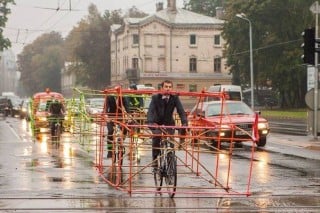
(Photo: Let’s Bike It!)
[This week’s Monday Roundup is sponsored by North St. Bags, celebrating their 5th year of making great bags in Portland.]
Here are the great bike links that caught our eyes this week:
Road space demo: Latvian bike commuters came up with an evocative (though probably wobbly) way to show how much space bikes save on the road.
“The Wash Cyclist”: A Philadelphia startup is preparing a national rollout of a cargo-trike laundry delivery service.
Violent tweet: A UK bike journalist landed in hot water after writing that a newspaper journalist who criticized “cycling vigilantes” should be “taken out and shot.”
Vocal distraction: Voice-activated dashboards and smartphones greatly increase driver distraction, two new studies found.
Denmark pushes on: As bike commuting in Copenhagen keeps rising (from 36% two years ago to 41% at last count) the city is widening bike lanes from three abreast to four abreast, among other changes.
Lane widths: If you could change just one thing about the United States, it should maybe be ending the supposedly safer but actually disastrous 12-foot-wide traffic lane.
Best transit: Here’s one way to rank the country’s top transit systems: by percentage of jobs reachable during the morning peak hours. (The Portland area ranks 11th.)
Hand-me-down bike share: Stymied by Alta Bicycle Share’s continuing lack of new equipment, DC’s thriving Capital Bikeshare is finally expanding by buying 250 used bike share bikes from Canada. Meanwhile, two New Jersey cities that had been planning to join Alta’s empire are switching to dockless systems.
Advertisement
Chinese bike sharing: China’s bike sharing systems are massive, but the biggest has been a flop and usage rates are low compared to European systems.
We still don’t have bike share: Seattle’s bike share system launches today, a fact that OPB used to rub salt in our lack-of-bike-share wounds.
Portland’s fall: The Bike Snob noticed our post last week about Walktober and fears we’ve “tumbled from grace so spectacularly that they’ve given up on bikes altogether.”
Floating joke: Citylab calls a concept for a floating eight-mile bike path atop the Thames “a whole club sandwich of wrongness, made up of many delectable layers of stupid.”
Blind-spot warnings: Here’s a nifty system that uses sound waves to detect people biking in a truck’s blind spot and flash a warning to both parties.
Missing the market: Too many cities invest in “the 2 percent who already bike, not the 98 percent who don’t,” says Gil Penalosa. (He’s previously called out bike maps and parking as examples of low-priority investments.)
St. Paul investment: Drawing on an idea advanced by Penalosa, St. Paul’s mayor is proposing a $42 million “8-80 vitality fund” to make streets better for young and old to bike on.
NYC casualty: Zelda, a beloved wild turkey who lived in Manhattan’s Battery Park since 2003 and survived Hurricane Sandy, has been killed by a car.
HR idea: Seems like a lot of workplace cultures would benefit from a monthly company bike outing.
NYC biking advocates Steven O’Neill and Doug Gordon bring the bromance in your inspiring video of the week, in which they attempt to count every bike over the Manhattan Bridge during 20 minutes one morning:
If you come across a noteworthy bicycle story, send it in via email, Tweet @bikeportland, or whatever else and we’ll consider adding it to next Monday’s roundup.


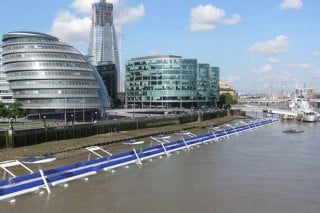
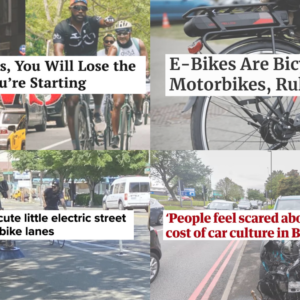
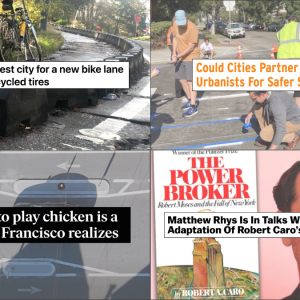
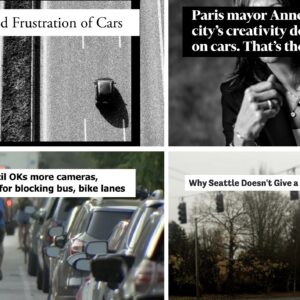
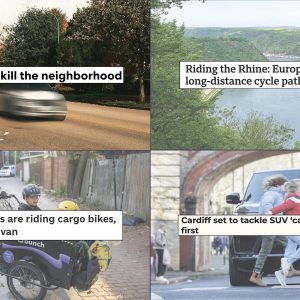
Thanks for reading.
BikePortland has served this community with independent community journalism since 2005. We rely on subscriptions from readers like you to survive. Your financial support is vital in keeping this valuable resource alive and well.
Please subscribe today to strengthen and expand our work.
What kind of weirdness is going on over at Alta? Mia Birk says all the right things, but something doesn’t smell right to me. Anyway, it’s probably just me. Carry on.
Seems like handling the vendors for bike share is just too different from designing infrastructure.
How much sourcing do they do on their design projects?
Just to put it out there, Alta Planning+Design and Alta Bicycle Share are two different companies that have very little to do with each other. They share some owners and admin, but they have different staff.
Portland needs to dump Alta and go with a dockless system. The costs seem like they would make a much more viable operation.
Latviešu velosepedis ir ļoti labi! Tres Nedēļas bija Latvija, un es redzeju daudz automašina Rīga. Okay, my Latvian is not so good. Anyway, I was in Latvia for three weeks this past summer, and was surprised to see how many cars dominated the streets or Riga. For a European city, Riga has a lot of catching up to do, but I think this video shows that there is a vibrant cycling community that is trying to make changes. One thing to note is that Latvia has an incredible bike museum in Saulkrasti, which is a beautiful town just north of Riga. Anyway, go to that museum, and you will see how vibrant bicycling was in Latvia before World War II. For three years in 1930’s they had unity rides through the summer, Riga hosted several bicycle companies (Erenpreis, Ozolnieks), and they even had defense unit on bicycles. I left with the impression that had the Soviet Union never illegally invaded (annexed) Latvia, Riga would have been the Copenhagen of the Baltics. Stupid Soviet Union!
Re: Bike Snob and “..given up on bikes altogether”, I think it speaks volumes, JMaus, that this blog is not so bike-obsessed to the exclusion of other modes of transpo.
$42 million for 8-80 improvements? I’m moving to Minneapolis! (That’s more than the entire Street Fee compromise is supposed to net, and it will have to pay for maintenance also.)
More seriously, we need to draw a line in the sand that 80% of any transportation revenue collected be used for safety. If the remaining 20% isn’t enough for maintenance, maybe we should try a gas tax.)
Everybody in St. Paul just groaned. 🙂
LOLs I guess that’s what I get for commenting while coding.
You should see me tease Seattleites about their helmet law. 😉
Not only is St Paul talking about spending $42 million, but Minneapolis has spent the last few years spending a $25M federal grant on bike route improvements.
I’m starting to think one of the biggest reasons Portland has stagnated and other cities are sucking our wheel is that we are not willing to spend the money it takes to get to the next level.
(Of course our disdain for recreational cycling doesn’t exactly help either, nor does our growing we-can’t-possibly-be-anything-but-#1 smugness, nor does our continued promotion of cycling as a moral issue.)
Except that cycling might actually be a moral issue, relative to driving. I suppose I’m just making it worse by pointing this out, but thousands of pedestrians dead in crashes, tens of thousands dead from air pollution, if killing random people for perceived convenience/comfort/time-savings isn’t a moral issue, then what is?
Sorry, in the interest of brevity I didn’t word that quite the way I meant it. Yes, cycling is a moral issue, in the sense that people who bike instead of driving are doing something morally good – on a number of levels. And we should do everything we can to promote cycling and its benefits and to make it safer.
But in Portland, we have too many purist true-believers crossing the line from positive promotion and personal virtue to condemning and criticizing anyone who doesn’t give up their car and bike everywhere. See the recent Comment of the Week story for reprehensible examples. Not only does this all-or-nothing mentality turn people off and hold us back politically, but it also discourages those who might consider cycling some of the time.
Speaking as someone who commuted to downtown St. Paul for years, rest assured that this is catchup. Head to Google Street View and follow me…
74 E 5th Street: look at that bike share dock, it’s huge! Too bad there’s no way to bike in or out of it. If you don’t want a stressful ride through downtown, an express or limited stop bus on MetroTransit is your best bet.
2397 Marshall Avenue: St. Paul welcomes you from your ride across Minneapolis on a rail-grade off-street trail with a steep hill and a door zone bike lane that’s squeezed out by snow banks between Christmas and Valentine’s at a minimum.
BTW: during that time, and the month before it, the average high temperature is subfreezing (0°C). There is only one adjustment to these conditions, and it’s in mileage. Most days, that number will be close to the temperature in degrees Celsius.
Always thought it would be funny to see a bunch of people wearing large refrigerator boxes, pushing their way through a line at the DMV or the bank, honking at everyone who’s not in a box.
Great idea Dan! I’m going to file that one away for future use.
Pedalpalooza ’15?
Actually, ranking by percentage of jobs reachable during rush hours is a terrible way to rank car-free living. How do you get to work or to a social event at 11pm in Seattle or Dan Jose?
Good point, Chris. I changed it from “a good way” to “one way.” Though this method is at least empirical.
Human Transit (Jarrett Walker) wrote about other information we would want to know, like percentage of jobs reachable by transit in a certain time, and the number at different hours (not just morning rush hour). http://www.humantransit.org/2014/10/access-across-america.html
extremely valuable links on lane width, thanks.
Robert:
If PDX could just replace Mia and Roger with you and Amy…
Had I been elected mayor in 2008 both of you would have been on my office payroll.
Everyone at Bike Portland:
Buy Robert Hurst’s “The Art of Urban Cycling.”
Buy Amy Walker’s “On Bicycles.”
Learn how and why to ride your bike down the street!
“The Art of Urban Cycling” has probably saved my life more than once. I picked up many tips that it would have taken me years to learn otherwise.
I appreciate that the AAA study is emphasizing the dangers of voice-activated systems (though one wonders how they would be worse than touchscreen systems), but something is wrong with their methodology if they rank talking with a passenger as slightly more distracting than holding a cellphone conversation on a handsfree device.
The CityLab article about 10′ versus 12′ traffic lanes makes a whole lot of sense. The 12′ standard might make sense on freeways, but on city streets it is an outdated relic from the 20th century model of promoting traffic flow above all else.
If you want an icy dip into the way the rest of America thinks, try reading these comments on the CityLab piece. https://news.ycombinator.com/item?id=8439977
That demonstration of “Look how much space bikes save” kinda bothers me. On a bike you *should* be given that much space. the purpose of a bike is not to let cars pass me one inch away so as to save road space.
hahaha…..but that is exactly how bike lanes are designed. Just enough space that if the bike or car isn’t riding on the line, that you get passed by motorists who don’t have to slow down to pass you, usually much closer than the typical 3′ buffer.
In my experience, in less room and traveling faster than most cars pass you when you take the lane.
On lane width – your basic deliver truck is 8+ feet wide, not including mirrors. A typical city bus is 9 feet wide, not including mirrors. A fire pumper truck is typically 9.5-10 feet wide, not including mirrors. Garbages trucks are similarly wide, or even wider. So there are pretty good reasons for trying to have 12 foot lanes. Even if you stripe a lane down to 10 feet, the truck is going to take up the same width. For how uncomfortable that is, see Hawthorne Blvd. It isn’t practical ($$$) to replace the entire truck and bus fleet in Portland with narrower models.
Funny though, Hawthorn isn’t on the high crash corridor list, however most the streets that make the list are wider streets with higher speed limits. Go figure.
Valuable observation about truck widths. Another benefit of 12′ wide lanes, is that having as part of the road right of way, lane width that at some point can possibly be shaved down some to create room for things like wider bike lanes, can help shorten the timeline fo, and cost of installation.
Yes, American trucks and buses tend to be wide, but they also haven’t changed design much since the 1950s. When you go to cities overseas you tend not to see 12′ lane widths, nor 10′ wide trucks. Only recently have we started to see imported designs like the Sprinter and Courier (and ironically the Japanese are building bigger platforms like the NV2500 to compete in the American market).
We could put in buffered bike lanes to reduce lane width and still accommodate emergency response. Where I live I’m celebrating a recent ‘half-victory’ where I’d repeatedly proposed replacing a dangerously (2+ cars) wide street lane with a RTOL lane and bike sharrows. I call it only a half-victory because they’ll be re-striping the lane to the same (reasonable) width as the adjacent (car) lane and putting in a colored and buffered bike lane… which they’ll still keep to the far right (of right-turning traffic).
I used to be really looking forward to bike share here in Portland, but now it has turned into an embarrassment. I wish it would just go away, officially, so that we can all move on to something else.
On NW Everett bikelane
http://nwexaminer.com/driving-out-cars
You kids get off my lawn!
Again, many drivers have no idea what inconvenience really is. Wah! I can’t teleport instantly across the city on my couch!
I recently thought of this Monday Roundup while reading a 1987 book titled “On Your Bicycle” by James McGurn. A photo’s caption in it reads:
“Members of le Monde a Bicyclette, the Montreal-based cycle campaign, showed how much urban road-space a car requires by touring the city-centre with their bicycles surrounded by car-size wooden frames. The campaign’s flair for imaginative and effective publicity has made it a model for other cycle campaign groups.”
That caption was beneath this photo: http://lemab.ca/manifs/1981ManifSpatiale.jpg
And while searching for that photo, I came across this quote:
“To raise public awareness, Le Monde à Bicyclette held theatrical public demonstrations including mass “die-ins” with cyclists lying down in major intersections.”
And that comes from this page: http://pedalmag.com/montreals-bicycle-bob-silverman-of-le-monde-a-bicyclette-celebrate-80th-this-weekend/
yeah going 5mph thats not creating traffic at all!!!